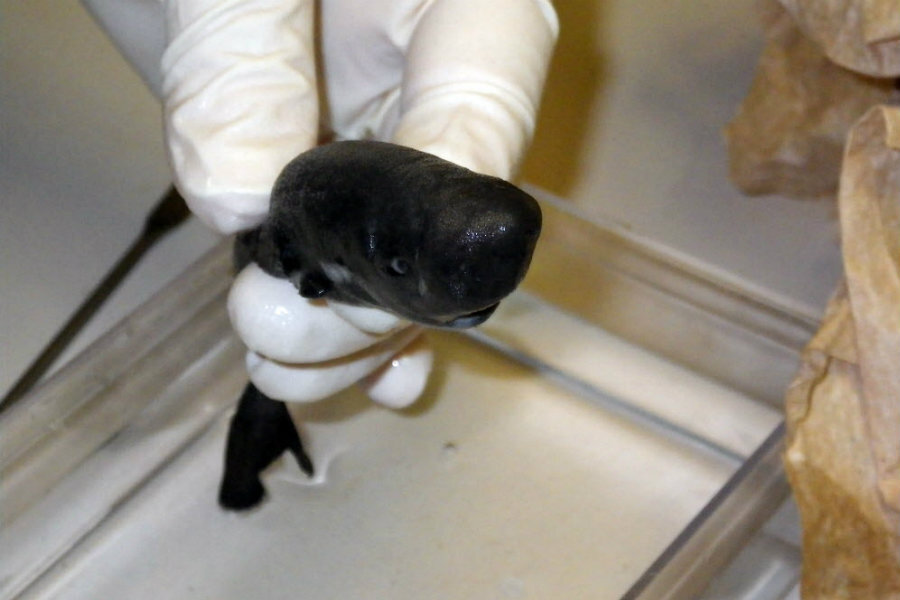Chihuahua of the sea? Scientists find rare 'pocket shark'
Loading...
It took more than 35 years, but researchers have once more laid eyes on the only species of shark small enough to fit in your pocket.
Nicknamed the “pocket shark,” the specimen – a young male about five inches long – is only the second ever found by scientists, who accidentally scooped up the small, rare animal in the Gulf of Mexico during a mission to study sperm whale feeding patterns in 2010. The pocket shark lay frozen in storage until 2013, when Mark Grace, a fisheries researcher for the National Oceanic and Atmospheric Administration (NOAA), found it at the bottom of a gallon bag.
The discovery, while valuable in and of itself, also serves to indicate the dearth of human knowledge about life in the deep seas.
“This record of such an unusual and extremely rare fish is exciting,” Dr. Grace said in a statement, “but it’s also an important reminder that we still have much to learn about the species that inhabit our oceans.”
To date, humans have explored only 5 percent of the Earth’s oceans, and most of what we do know revolves around life in shallower waters, according to NOAA. And while the entire ocean floor has been mapped to a resolution that allows scientists to spot major features such as mid-ocean ridges and trenches, less than 0.05 percent has been mapped to a level of detail where researchers can see deep undersea volcanic vents or the wreckage of missing aircraft.
A big part of the problem is funding. Sending expeditions deep underwater is prohibitively expensive, as Hollywood director and deep-sea enthusiast James Cameron proved when he spent $8 million on his record-setting dive into the world’s deepest point, the Mariana Trench. Yet NOAA’s undersea exploration program received only about $23 million in government funding for 2013 – a fraction of NASA’s $3.7 billion budget that same year.
As a result, “we know less about the deep sea than the surface of the moon,” Gavin Naylor, a biologist and genetic specialist at the Medical University of South Carolina, told Newsweek. “There are so many unusual organisms down there.”
The pocket shark, scientific name Mollisquama parini, appears to be one of them.
First discovered in 1979 off the coast of Peru, the shark is named not for its diminutive size – the original specimen was an adult female a little more than 15 inches long – but for the “remarkable pocket gland” just above its pectoral fin, according to a study led by Grace and published in the journal Zootaxa.
Scientists don’t know what the pocket is for, though they’ve guessed that it may produce or secrete pheromones that either attract potential mates or fend off predators. The pocket shark is most closely related to the kitefin and cookie cutter sharks, the study found.
This latest specimen, Grace noted, was young enough to display an unhealed umbilical scar, leading him and his team to wonder “where mom and dad may be, and how they got to the Gulf. The only other known specimen was found very far away.”
Over the years, plenty of other strange and interesting creatures, including meter-long eels and huge crustaceans known only as “supergiants," have been discovered as a result of deep-sea exploration. And even the ones that have already been discovered - such as the vampire squid - that scientists are still learning the basics about their reproduction cycles and lifespans.
But understanding the ocean can also be beneficial to humankind, too. The information gathered from deep-sea ecosystems could lead to new sources of food, energy resources, and medicine. Tackling the challenge of deep-ocean exploration could produce innovations that could be applied elsewhere. Most pertinently, ocean exploration helps scientists "establish the baseline information needed to better understand environmental change," help predict earthquakes and tsunamis, and shed light on how humans affect the environment and vice versa, according to NOAA.
“As a scientist, I want to explore the great wonders our ocean has to offer,” Greg Stone, executive vice president at Conservation International, wrote for The Huffington Post. “As a conservationist, I need to explore the vital human-ocean connection: how the ocean can provide for people and how our impacts affect the health of our oceans. This is critically important for us this century.
“Healthy oceans can help ease the increasing burden our population is placing on this planet,” he added, “but we need to be able to explore, observe and learn about the oceans in their entirety in order to protect and conserve them effectively.”






